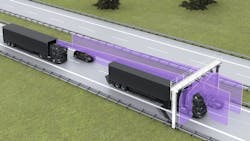LiDAR-based vehicle detection and classification system operates in free-flowing traffic
The SICK Free Flow Profiler is a LiDAR-based system that can detect, measure, and classify vehicles while they drive freely down roadways. The system consists of SICK LMS511 eye-safe 2D LiDAR sensors that use 905 nm lasers, have an aperture angle of 190°, and an operating temperature range of -40° to 60° C, and a central processing unit called the Traffic Controller FPS.
In the default setup for basic vehicle profiling, two LiDAR sensors are mounted above the road on either side. These sensors scan the upper and side contours of the vehicle, which produces point clouds of 2D profile sections. The width LiDAR sensors also generate measuring points for the vehicle lane. If those measuring points change, the Profiler system can tell that the width sensors are not properly aligned.
A third sensor above the road in the middle of the lane scans the front and roof of the vehicle as it approaches, which calculates the length and speed of the vehicle. The Traffic Controller uses this information to track the relative locations of the 2D profile sections, combine them into a 3D point cloud, and calculate the vehicle dimensions and class with profiling software.
As with other LiDAR-based systems, the accuracy of the Profiler can be affected by weather conditions. The Profiler can filter out measuring points generated from weather like rain or snow, versus points generated from vehicle scans, however.
"While looking at all data points, the irrelevant points in the pattern can be filtered away," said Monika Bantle, Product Manager at SICK. "Of course, there are verification algorithms included as well considering the overall point cloud. To distinguish rain or snow from the side mirrors or large spindrifts from a trailer are the more difficult parts, especially when it comes to dimension measurements with high accuracy requirements."
Proper installation of the sensors and finding a location for the system where the road condition is constant are important for the Profiler to function properly. If there are large piles of snow or leaves within the scanning area, or if the road surface is extremely dark due to fresh paving, or if the road is extremely wet, the measuring points for the vehicle lane taken by the width sensors can be thrown off. If static objects like lane barriers, guardrails, or bumps in the road are within the field of view of the length sensor, length and speed measurements can become less accurate. Users are made aware of these challenges.
The Free Flow Profiler can be used to scan multiple lanes of traffic, depending on the number of sensors hooked into the system. Vehicle classification can be accomplished at speeds up to 250 km/h (approx. 155 mph). For vehicle measurement, slower speeds provide more accurate results. Horizontally-placed sensors can be used to count axles, which can assist in the operation of automated toll systems.
The Profiler's vehicle classification functionality was the basis of one of the system's large-scale deployments, at the Tallinn Passenger Port in Tallinn, Estonia, where the Profiler calculates vehicle dimensions as they enter the port and assigns vehicles to specific boarding lanes in order to assist with efficient ferry loading procedures.
Related stories:
ON Semiconductor and 3M collaborating on roadway safety
Trials conducted in UK on AI platform designed to assist with air traffic control
Cornell University study suggests stereo camera systems could replace LiDAR
Share your vision-related news by contacting Dennis Scimeca, Associate Editor, Vision Systems Design
To receive news like this in your inbox, click here.
About the Author

Dennis Scimeca
Dennis Scimeca is a veteran technology journalist with expertise in interactive entertainment and virtual reality. At Vision Systems Design, Dennis covered machine vision and image processing with an eye toward leading-edge technologies and practical applications for making a better world. Currently, he is the senior editor for technology at IndustryWeek, a partner publication to Vision Systems Design.

